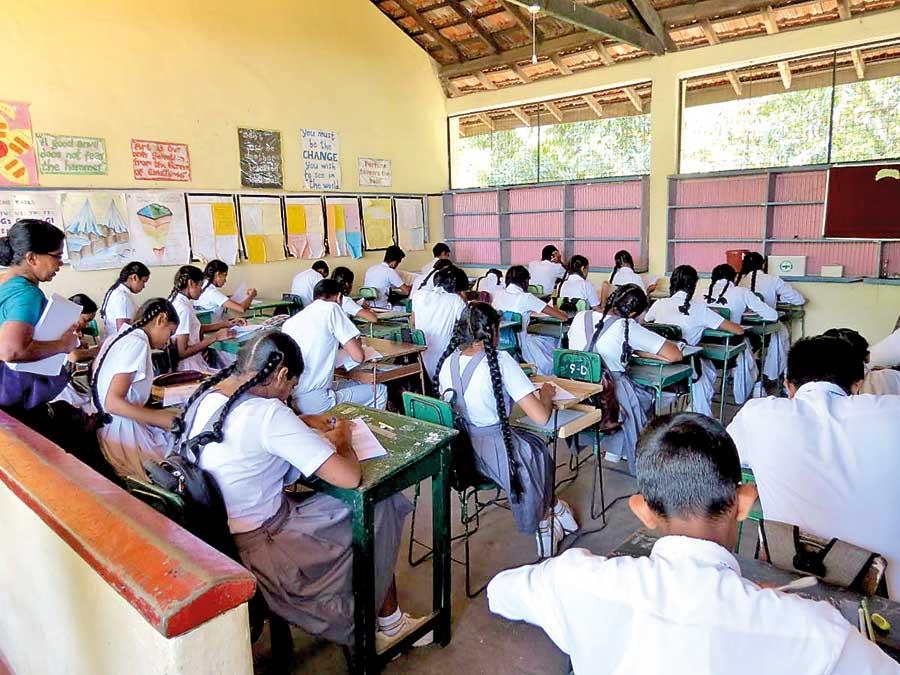04 May 2020 - {{hitsCtrl.values.hits}}

Revisiting the demand for English medium education today Implementation of a medium of instruction policy without taking into account realities will only serve to further complicate an already tense linguistic and educational landscape
It may seem a little strange to be writing about a topic like English Medium Instruction when schools and universities have been closed to contain the spread of COVID-19 in our country.
However, during a time like this, it can also be helpful to pause and reflect on some of the ideas that seem to have become widely accepted as ideal and practical. 
One such idea relates to the belief among many, including those who have the power to influence policy, that high-quality education and relevant education is an education in the English medium.
In a now largely forgotten incident relegated to infamy a student of a leading school in Colombo who was studying in the then newly implemented “English medium”, called her school mate in the parallel mother tongue medium class, (during a fight) “You Sinhala medium bitch”.
This was in 2002, almost two decades ago, but it is still relevant in terms of how it mirrors the enormous linguistic discrimination that characterizes the Sri Lankan polity, and how it invokes the politics of language in the country.
Indeed the medium of instruction debate is beleaguered by a number of tensions both at conceptual and policy level as well as at ground level, in its implementation.
One of these policy level tensions is the one between an Education for All (EFA) goal and the need to be proficient in a global high-currency language such as English.
The other is the tension between the necessity of preserving local languages/identities and the need to accommodate the pressures of learning an internationally valued lingua franca.
Many countries struggle with this tension and a brief look at their language policies would confirm this. The other tension is the one between policy and its implementation in the classroom due to various
structural challenges.
Even as I write this I am aware that the expressing of my opinion may be viewed as being fraudulent and hypocritical, since I already have, and had, throughout my childhood, access to the linguistic capital that is the English language.
There is a common (and sometimes justified) suspicion and a perception among many, that certain academics advocate local languages, or “sub-standard” English for the “masses” while they, themselves have access to both “standard” as well as “sub-standard” varieties which they can use interchangeably, manipulating language politics in a way that only those who possess this capital can.
However, I take the risk of being labelled thus, because I have been keenly observing the developments and debate surrounding this subject since the time of my postgraduate research, and feel the need to comment on the widespread belief that English medium instruction will solve all problems related to language competence
Many policymakers, teachers, parents, and academics often think of English Medium as a magic wand, the panacea for everything wrong in our education system and the one-fits-all solution for unemployment. Besides, English is often popularly perceived and Constitutionally affirmed as a “link” language in the hope that it would “link” the communities which were/are embroiled in the ethnic conflict. In this sense, there is a rather naive assumption that English can be a “tool” which can be objectively used for material success, removed from all ideological underpinnings or complications.
But as I hope to show, these views often ignore a number of significant considerations that have a direct impact on the successful implementation of language-based education policy.
Some years ago, when researching the English medium policy (it was later labelled “bilingual education”) and its implementation for my doctoral thesis I asked some of the pioneers of the most recent English medium initiative what the rationale was, and I was told that it was because the English teaching project of the past half-century was “a total and utter failure”. The implications of this are that the English medium initiative was meant to replace the inefficient English language teaching one.
However, its replacement, the model of bilingual education on which the rationale of the current English medium/bilingual education programme is based on, originated in Canada in what was termed “Immersion” education. This form of education emerged out of demands by Anglophone parents who wanted their children to be fluent in French and thus have access to the linguistic capital of being bilingual in Canada. The immersion model is where parents of linguistic majority children with a high-status mother tongue (i.e English speakers in Ontario, Canada) choose voluntarily to enrol their children in a programme in which instruction is conducted through the medium of a foreign/minority language (i.e. French).
Several significant differences between the linguistic and educational context in Ontario and the educational context of Sri Lanka must be highlighted.
"Most importantly, we need to keep in mind that a one-size-fits-all solution of teaching every subject at every level in English medium will not effectively help our young people to become fluent in English"
Firstly, most of the children who were learning in a bilingual educational stream in Ontario were children with the same mother tongue (e.g. English). English was also the language of the majority in the country. In Sri Lanka however, while we may find students who have the same mother (i.e. Sinhala or Tamil), it is significant that English is not the language of the majority in the country. Further, from an educational perspective, the teachers in the immersion programmes offered by schools in Ontario are bilingual which means that children can initially at least, use their language and still be understood.
In contrast, the situation for teachers working in the English medium in Sri Lanka is very different. In studies that I have done, both as a doctoral student as well as later, for the National Education Commission, it has been found that there is a shortage of adequately qualified teachers to teach in English and this is a significant barrier to the success of an English medium instruction policy.
Even in some leading schools in Colombo where I conducted my research, I found that there was a tendency towards rote learning and choral responses in classrooms I observed, because of the teacher’s lack of confidence in using English.
Given the differences between the linguistic and educational contexts in Canada and Sri Lanka, it is not surprising that the implementation of an English medium instruction has proven to be a significant challenge for both students and teachers.
In countries such as Canada, English medium instruction policies are implemented in additive language learning contexts in which children’s mother tongue is not in danger of being replaced by the language of instruction. However, the uncritical implementation of the same policies in Sri Lanka, with its unique linguistic and social context, is likely to result in a situation of subtractive bilingualism and language learning.
In these learning environments, students are likely to gain proficiency in one language but lose competence in their mother tongue. Students are likely to be “submerged” in an English medium education, also known as “the sink or swim” model, forced to accept instruction through a foreign majority/official/dominant language, in classes in which the teacher does not understand the minoritised mother tongue.
They are also likely to be aware that the language of instruction constitutes a threat to their dominant language, which runs the risk of being replaced. What this means in practice is that since Sinhala and Tamil are both diglossic languages (which mean there are “high” and “low” varieties of the same language, depending on the function, and also differences in written and spoken varieties), competence in the more formal versions of Sinhala and Tamil will vanish and students will only be able to mainly utilize the language for colloquial communication with family and friends for activities such as gossiping or shopping.
Sri Lanka is not alone in this situation as many countries around the world have been grappling with the tension between the necessity of preserving local languages/identities and the need to accommodate to the pressures of learning an internationally valued lingua franca such as English.
How then are we to move forward in implementing a medium of instruction that is both sensitive to these tensions while at the same time cognizant of the demands of an increasingly globalized economic system? We can start by realizing the need to critically examine the cliché that equates a quality education with English medium education.
The UNESCO advocates Mother tongue-based bilingual programs which use the learner’s first language, to teach beginning reading and writing skills along with academic content. It points out that the second or foreign language should be taught systematically so that learners can gradually transfer skills from the familiar language to the unfamiliar one. Bilingual models and practices vary as do their results, but what they have in common is their use of the mother tongue at least in the early years so that students can acquire and develop literacy skills in addition to understanding and participating in the classroom.
Additionally, we also need to find a way to improve students’ spoken as well as written English, both the skills of Basic Interpersonal Communication Skills and Cognitive Academic Language Proficiency. Generally, cognitive academic language proficiency is transferable from one language to another. Furthermore, careful planning and implementation of teaching a few selected subjects in the English medium in addition to strengthening the teaching of English language using either a Content-Based Instruction or CLIL (Content and language integrated learning) model, where, at both university and school level, subject/content teachers and language teachers work collaboratively to optimize language learning among students must also be explored, instead of a wholesale overhaul of the medium of instruction and changing it to English medium.
The implementation of a medium of instruction policy without taking into account these realities will only serve to further complicate an already tense linguistic and educational landscape and make it even more difficult to effectively improve the teaching and learning of English in Sri Lanka today.
Dr Vivimarie Medawattegedera is a Senior Lecturer attached to the Language Studies Department of the Open University of Sri Lanka.
08 Nov 2024 25 minute ago
08 Nov 2024 2 hours ago
08 Nov 2024 3 hours ago
08 Nov 2024 3 hours ago
08 Nov 2024 5 hours ago